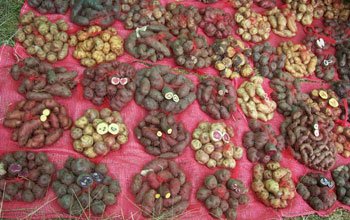United States
July 11, 2011
An international consortium of scientists has produced a new map of the potato genome that may lead to the development of an ultra-nutritious potato that could help feed the world's hungry.
By sequencing and identifying genes in the genome of the potato, the consortium has, for the first time, tied specific potato genes to their functions. Resulting insights into the growth and development of potatoes may enable scientists and breeders to produce potatoes that are more nutritious, more disease resistant and less dependent on pesticides than conventional potatoes.

Various types of potatoes that are grown in Peru. These potatoes differ in shape, skin pigmentation and flesh pigmentation.Credit: C. Robin Muell, Michigan State University
The potato is the world's number one non-grain food commodity, and serves as a primary source of energy for many poor people in developing countries. What's more, the popularity of the potato is expected to increase as the world's population soars. Therefore, by improving the nutritional value of potato crops and making potatoes easier to grow, scientists will increase the nutritional intake of a large and expanding population of potato-dependent people.
The National Science Foundation funded the consortium's research, which was published online July 10 by the science journal Nature.
Potato crops are particularly popular in developing countries because they yield food quicker and require less land than any other major crop--major advantages in developing countries where pressure on land and water is fierce. In addition, potatoes can be grown in varied landscapes, including mountains, plains, plateaus and subtropical lowlands.
The consortium released a draft map of the potato genome in 2009. However, Robin Buell, a Michigan State University plant biologist who is a member of the consortium, explained, "since our initial release of the sequence in 2009, we have improved the quality, identified and analyzed the genes and analyzed the genetic basis for the biology of the potato and its tuber," which is the edible part of the potato.
View a video with Robin Buell of Michigan State University.